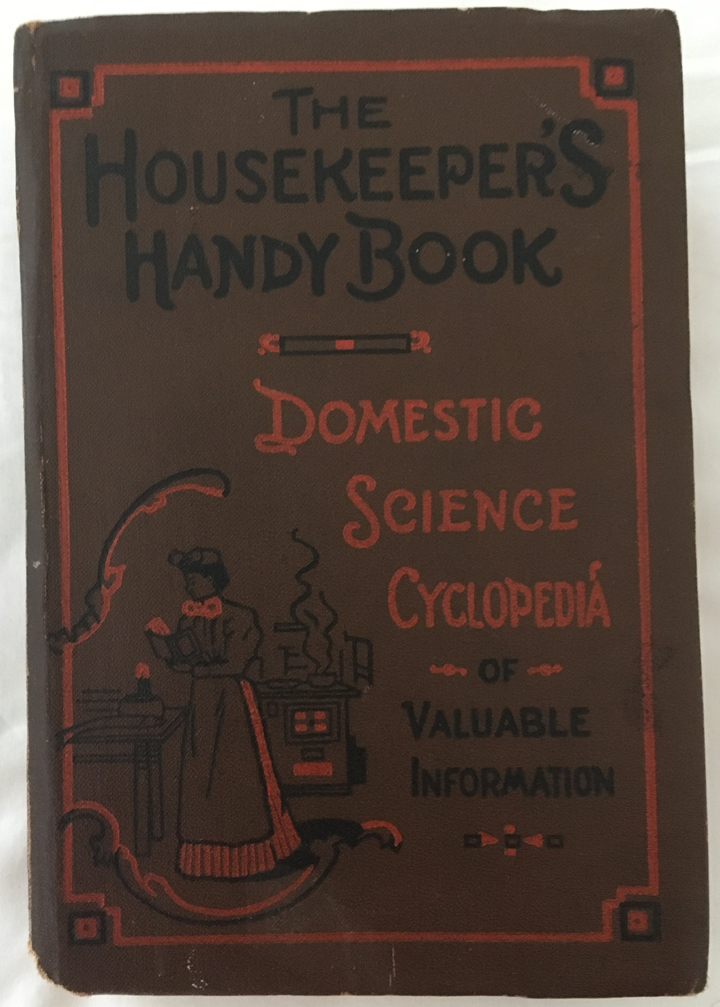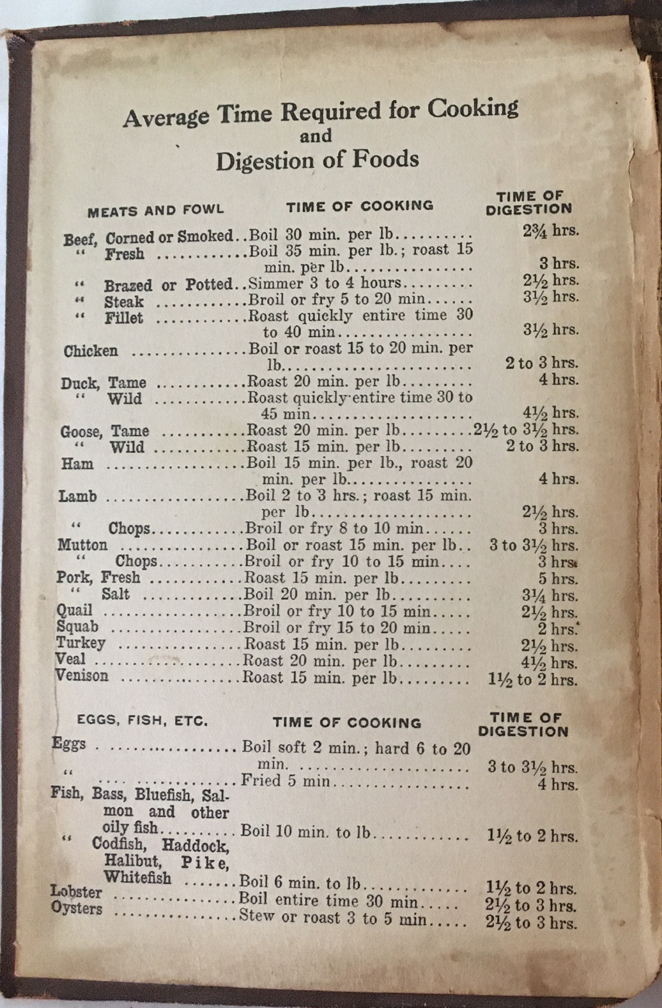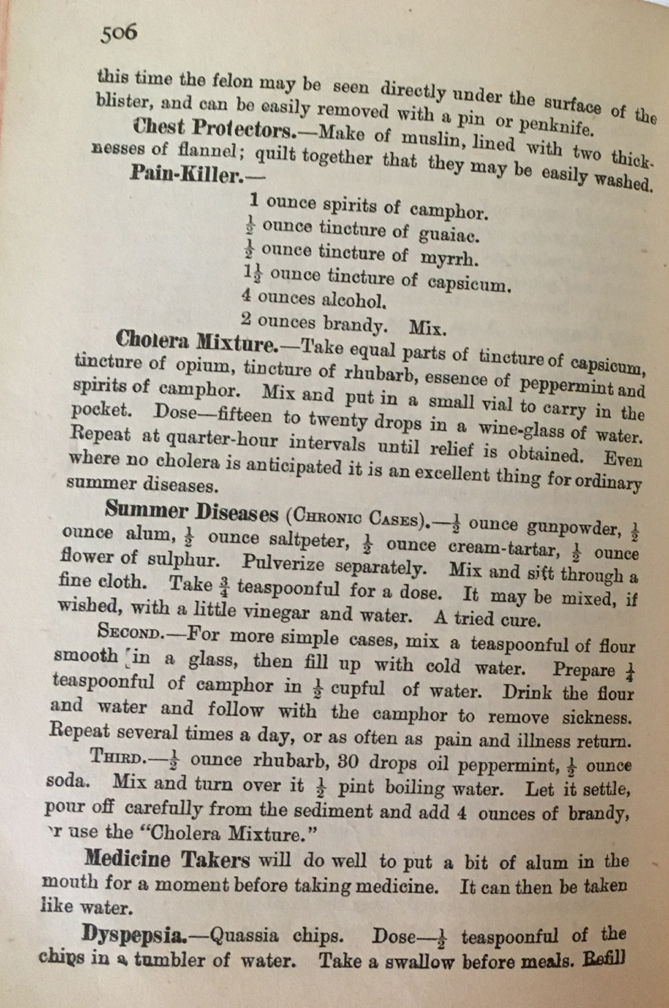52 Ancestors,
in 52 Weeks
Week 5:
In The Kitchen

An Old Book In The Kitchen
This weeks prompt brought back a childhood memory of reading an old book in the kitchen at my uncle Frank’s. I have previously written about Uncle Frank (1883-1974), including last year for the week 5 prompt. [1, 2] While we visited with my uncle I would entertain myself and the adults would talk. If the weather was cold or rainy I would stay in the house and look through Frank’s old photos, letters and books. One old book he kept in the kitchen particularly fascinated me, The Housekeeper’s Handy Book. [3] When Frank died, I selected this book to keep as a memento and I still have it today.
Housekeeper’s Handy Book
The full title of this old book is The Housekeeper’s Handy Book: A Comprehensive Cyclopedia of Useful Information and Domestic Science in the Home. The title was enough to intrigue a child. Inside the publisher promises it is the “Best Way of Doing Things” covering over “2200 subjects.” That’s a big promise for fewer than 600 pages. But, what I think first drew me to this book as a child was the unusual cover. It’s not leather, or paper, it is some sort of treated fabric. And the cover design is quaint and rustic. All in all, it was very different from the books I was familiar with at the time. When I first thumbed through this book it was already more than 50 years old, now it’s more than 100!
Not the Usual Recipes
As soon as you open the Housekeeper’s Handy Book you will see why I found it a curiosity. On the inside page are digestion times for meat and fowl. Why does it take 30 minutes more to digest wild duck versus tame? Then, in the introduction, the author shares the view of “good cookery” equating to “mental energy.” And, the study of culinary art is as important as the study of arithmetic and grammar. But it’s the recipes that are truly intriguing. Some seemed a bit gruesome, like how “To Clean Calf’s Head and Feet” and then make a soup, entree or jelly with them. [4] On the other hand, I couldn’t wait to try the ice cream recipes. [5] I got the chance to set up this old fashion style of churning cream when I was in scouts, and it is far more difficult than the author presents.
Naturally I was attracted to the recipes for sweets of all kinds. From pastries to cake and jelly to candy, although some being savory seemed odd to me at the time. Who wants tomato jelly, vinegar candy or custard made from farina? [6] Some of the dessert recipes would be terrific on my favorite baking competition show, like Watermelon Cake, Prince of Wales Cake, or Bird’s Nest Blanc-Mange. [7]
Of course, you will find plenty of recipes for entrees and vegetables. If you are looking for an old-timey recipe, or traditional food preparations, this book surely has those. Consider Oyster Stew, Squirrel Pot-Pie, or Fried Green Tomatoes. [8] I think some of these old recipes could be popular today with cooks wanting to use whole, natural or curative ingredients. There are many recipes using ingredients like graham flour, ginger, cider vinegar, sweet potato, etc. Oh, and don’t miss the recipes for condiments and pickling. [9]
Tips for the Housekeeper
Besides all the food recipes there are also tips for keeping house, homemade medicines and cosmetics. Tips To Purify Drains include using something called copperas, or try common road dust. [10] There is a whole section for Calcimining and Wallpaper and another for the Care of Lamps, neither are much called for today. [11] In the section for washing there are several recipes for soap and loads of tips for laundering and caring for various fabrics. Caring for black lace is different than caring for white lace. And, don’t throw out your old kid gloves since they can be used for restoring your colored silks. [12] There are also recipes for making colored dyes, annotto (what is that?) evidently makes a soft orange color.
Tips for caring for the sick include: never whisper and don’t tell discouraging stories. And there is a comprehensive list for treating various poisons. Although, where would I get white oak bark or slippery-elm to make a tea? [13] The same can be asked for many of the ingredients used in the various medicines: tincture of myrrh, gunpowder, fox-glove, ashes of a cigar? On the other hand, many of the remedies rely on vinegar and eggs.
The final chapters are dedicated to personal hygiene and miscellaneous tips. The tip for treating facial wrinkles involves the use of turpentine. No thank-you. On the other hand, to drive away rats and mice: spread sprigs of peppermint. That seems very reasonable. [14]
Conclusion
This is a fair sampling of why this old book intrigued me so much as a child, and still a bit today. The recipes and tips often call to mind a bygone time. For those interested in family history the Housekeeper’s Handy Book can add dimension to how our ancestors lived.
I do not know how this book came to be in my uncle’s small collection of books. I never thought to ask. My aunt Grace (1887-1954) has her name on the inside back cover, so I am fairly certain they were the original owners of the book. Perhaps it was a gift when Frank and Grace were still a young married couple. Thumbing through the book today reminds me of my uncle Frank and sitting at his dining table in the kitchen.
EPILOGUE
While I was writing this post I discovered the Housekeeper’s Handy Book has been digitized! You can download it, or read online, and enjoy the old recipes and tips yourself. [15] Use the button below or follow the link in the Sources section. The button or link will redirect you to Google Books. Enjoy!
SOURCES:
- Post: “Frank Takeo Flucawa” October 2014 https://barblafara.com/frank-takeo-flucawa/
- Post: “So Far Away” February 2020 https://barblafara.com/so-far-away/
- The Housekeeper’s Handy Book: A Comprehensive Cyclopedia of Useful Information and Domestic Science in the Home, by J. R. Peper, Published in The United States by L.W. Walter Company, 1915, 576 pages.
- Ibid Ibid, page 23
- Ibid, page 374
- Ibid, pages 340, 348 and 385
- Ibid, pages 254, 273, and 365
- Ibid, pages 47, 58, and 157
- Ibid
- Ibid page 446
- Ibid, pages 455 and 457
- Ibid, page 472
- Ibid pages 490 and 491
- Ibid pages 516 and 535
- Entry for “The Housekeeper’s Handy Book” at Google Books online:
https://www.google.com/books/edition/The_Housekeeper_s_Handy_Book/TtRQAQAAIAAJ?hl=en











0 Comments